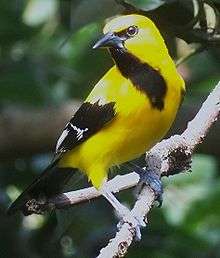Yellow oriole
| Yellow oriole | |
|---|---|
 | |
| Scientific classification | |
| Kingdom: | Animalia |
| Phylum: | Chordata |
| Class: | Aves |
| Order: | Passeriformes |
| Family: | Icteridae |
| Genus: | Icterus |
| Species: | I. nigrogularis |
| Binomial name | |
| Icterus nigrogularis (Hahn, 1816) | |
The yellow oriole (Icterus nigrogularis) is a passerine bird in the family Icteridae. It should not be confused with the green oriole, sometimes alternatively called the Australasian yellow oriole, Oriolus flavocinctus, which is an Old world oriole.
The yellow oriole is also called the 'plantain' and 'small corn bird', and in Venezuela it is known as 'gonzalito'. It breeds in northern South America in Colombia, Venezuela, Trinidad, the Guianas and parts of northern Brazil, (northern Roraima state, and eastern Amapá). The yellow oriole is a bird of open woodland, scrub and gardens. Its nest is a 40 cm-long hanging basket, suspended from the end of a branch. The normal clutch is three pale green or grey eggs.
This is a 20–21 cm long, 38 g weight bird, with mainly yellow plumage, as its name suggests. The adult male has a black eye mask, thin black throat line, black tail and black wings with a white wing bar and some white feather edging.
The female is similar but slightly duller, and the juvenile bird has an olive-tinged yellow back, and lacks black on the face.
There are four subspecies of yellow oriole, of which three are restricted to islands. They differ from the widespread nominate race of the mainland in body and bill size, and minor plumage details.
This species eats mainly large insects, but will also take nectar and some fruit.
The song of the yellow oriole is a pleasant melodious fluting, with some buzzing. The calls include a cat-like whine, and chattering noises.
References
- ↑ BirdLife International (2012). "Icterus nigrogularis". IUCN Red List of Threatened Species. Version 2013.2. International Union for Conservation of Nature. Retrieved 26 November 2013.
- New World Blackbirds by Jaramillo and Burke, ISBN 0-7136-4333-1
- Birds of Venezuela by Hilty, ISBN 0-7136-6418-5
- ffrench, Richard (1991). A Guide to the Birds of Trinidad and Tobago (2nd ed.). Comstock Publishing. ISBN 0-8014-9792-2.
External links
- Stamps (for Netherlands Antilles, Trinidad and Tobago) with RangeMap
- "Yellow Oriole" photo galley VIREO Photo-High Res
